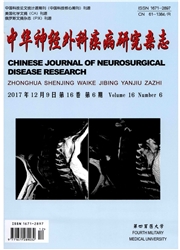

 中文摘要:
中文摘要:
目的 建立新的家兔症状性蛛网膜下腔出血模型。方法 采用单侧颈动脉结扎后枕大池二次注血的方法制成兔蛛网膜下腔出血(SAH)模型。实验分为4组,即正常对照组(N组)、结扎右侧颈总动脉组(L组)、枕大池二次注血组(SAH组)、结扎后枕大池二次注血组(L-SAH组)。观察并比较各组动物神经功能改变、基底动脉经颅多普勒超声血流速度变化以及基底动脉和海马形态学变化。结果 SAH组和L-SAH组均出现了神经功能症状,SAH组较轻,L-SAH组较重且持续时间长。SAH组和L-SAH组枕大池二次注血后血流速度均明显加快,根据平均血流速度计算的基底动脉痉挛程度:SAH组在二次注血后1d、3d、7d分别为32.70±5.81、21.29±7.98、4.21±6.55;而L-SAH组为29.97±6.37、21.51±10.25、12.40±7.46。结论 兔单侧颈动脉结扎后枕大池二次注血可制成症状性蛛网膜下腔出血模型,可用于研究SAH后神经功能损害及药物干预。
 英文摘要:
英文摘要:
Objective To build a novel model of symptomatic subarachnoid hemorrhage (SAH) in rabbit. Methods A total of 20 rabbits were divided randomly into 4 groups, including normal control group, ligation group (ligating the fight conmlon cervical artery), SAH group (twice injecting autolngus arterial blood into the cistern magana) and L-SAH group (twice injecting autologus arterial blood into the cistern magana combined with ligation of the right cenmlon cervical artery). Etiology of rabbits was recorded, transcranial Doppler (TCD) examination was performed, and morphological changes of basilar artery and hippocampus were observed to evaluate the value of this model. Results All the rabbits in SAIl and L-SAIl group developed neurological deficit. Compared with rabbits in SAH group, the neurological deficits of rabbits in L-SAH group were mare severe and lasted much longer. The flow velocities of the basilar artery significant increased in SAH and L-SAIl group. The strait degree of basilar artery diameter which was calculated according to the flow velocities were 32.70±5.81, 21.29 ± 7.98, 4.21 ±6. 55 on 1 d, 3 d and 7 d after SAH in SAH group, respectively. In L-SAH group, they were29.97±6.37, 21.51±10.25, 12.40±7.46, respectively. Conclusion This novel model can elicit symptomatic cerebral vasospasm in rabbit and this model can be used to investigate the mechanism of neurological deficit after SAH and efficacy of medical treatment.
 同期刊论文项目
同期刊论文项目
 同项目期刊论文
同项目期刊论文
 The effect of ecdysterone on cerebral vasospasm following experimental subarachnoid hemorrhage in vi
The effect of ecdysterone on cerebral vasospasm following experimental subarachnoid hemorrhage in vi The effect of oxyhemoglobin on the proliferation and migration of cultured vascular advential fibrob
The effect of oxyhemoglobin on the proliferation and migration of cultured vascular advential fibrob The effect of oxyhemoglobin on the proliferation and migration of cultured vascular smooth muscle ce
The effect of oxyhemoglobin on the proliferation and migration of cultured vascular smooth muscle ce 期刊信息
期刊信息
